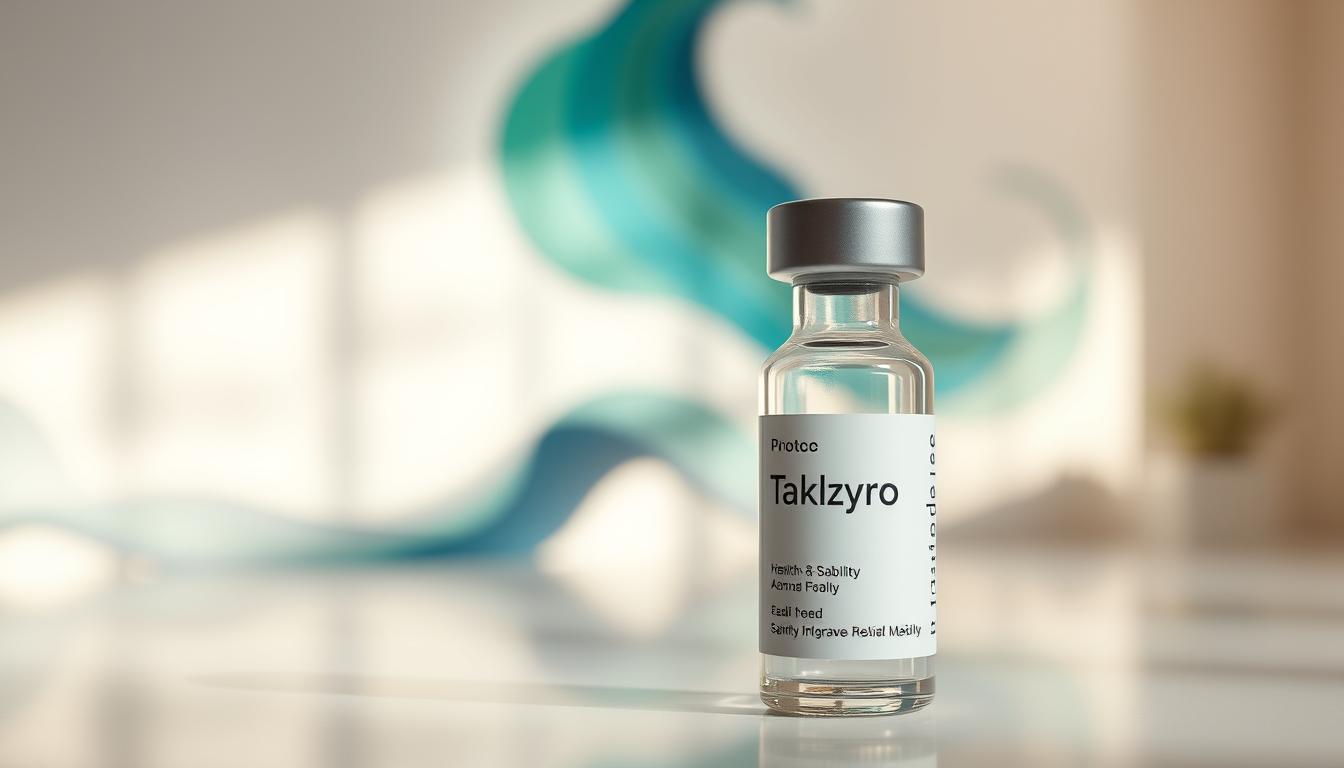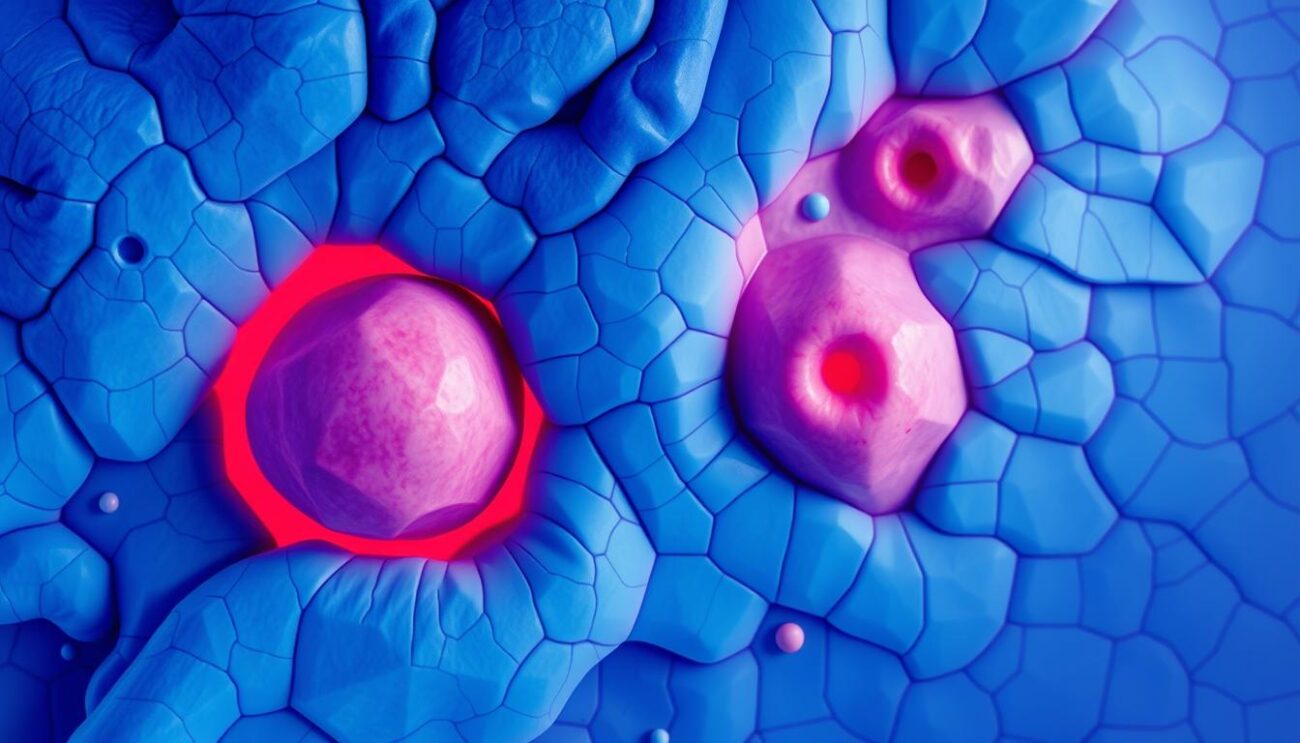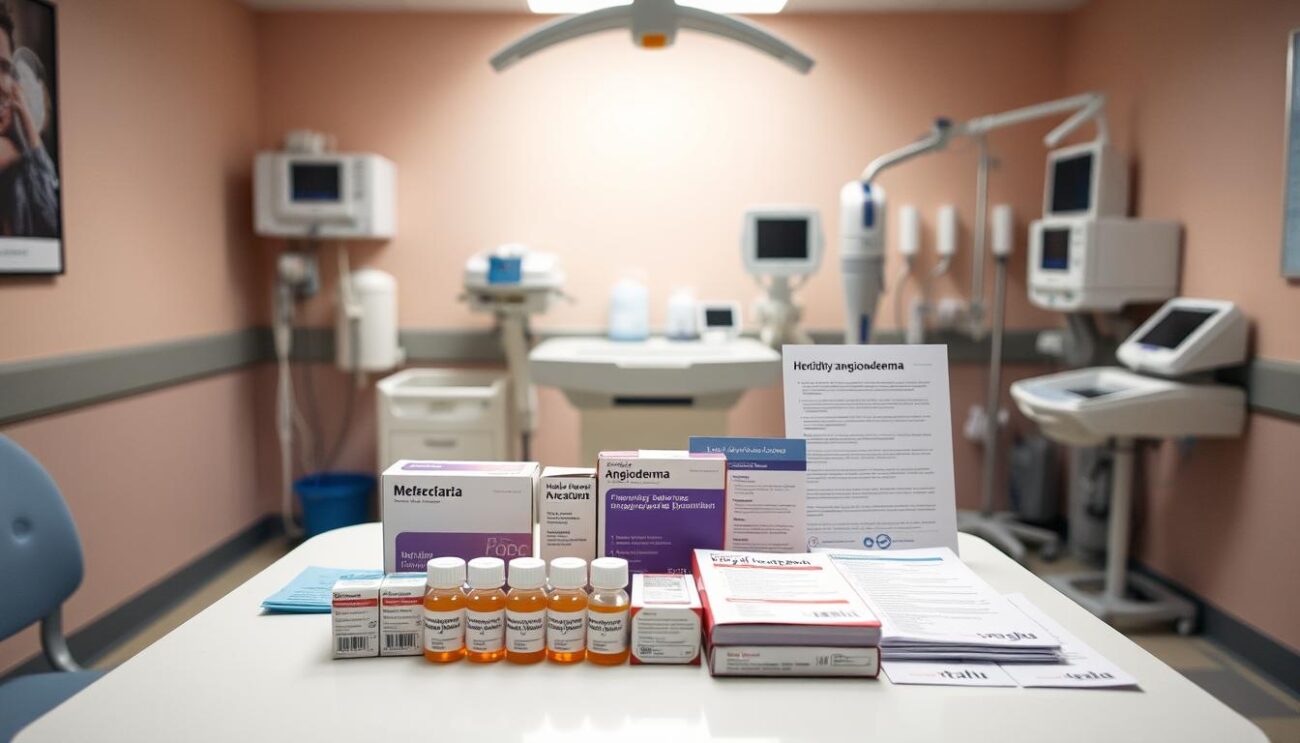Imagine a treatment that could greatly reduce the number and severity of hereditary angioedema (HAE) attacks. Takhzyro is a groundbreaking monoclonal antibody. It’s changing how we manage this rare and serious condition.
Takhzyro, developed by Shire, is a game-changer for HAE patients. It works as a preventive treatment by targeting a key cause of HAE attacks. This is plasma kallikrein, which Takhzyro effectively blocks.
Key Takeaways
- Takhzyro is a preventive treatment for hereditary angioedema (HAE) attacks in patients 2 years and older
- It is a monoclonal antibody that inhibits plasma kallikrein, a key mediator of HAE attacks
- Takhzyro has been shown to reduce HAE attacks by 87% on average compared to placebo in clinical studies
- Takhzyro is administered as a subcutaneous injection once every two weeks, making it a convenient long-term prophylaxis option
- The medication has demonstrated consistent safety and efficacy in long-term clinical trials
What is Takhzyro?
Takhzyro: A Monoclonal Antibody for Hereditary Angioedema
Takhzyro (lanadelumab-flyo) is a new treatment for hereditary angioedema (HAE). It works for people 2 years old and up. It’s a human monoclonal antibody that stops plasma kallikrein, an enzyme involved in HAE attacks.
By stopping plasma kallikrein, Takhzyro prevents bradykinin release. Bradykinin causes swelling and inflammation in HAE. This helps prevent HAE attacks.
Studies show Takhzyro cuts down HAE attacks. Patients on Takhzyro had fewer and less severe attacks. Those on placebo had more attacks.
| Dosing Frequency | Average Attacks per Month |
|---|---|
| Takhzyro every 2 weeks | 0.3 |
| Takhzyro every 4 weeks | 0.5 |
| Placebo | 2.0 |
Takhzyro is safe, with common side effects like injection site reactions and headaches. It’s not tested on pregnant or breastfeeding women. Use with caution in these groups.
“Takhzyro is a breakthrough treatment that has the potential to significantly improve the lives of patients with hereditary angioedema by reducing the frequency and severity of their attacks.”
Takhzyro’s Effectiveness in Clinical Trials
Takhzyro (lanadelumab-flyo) has shown great success in preventing and reducing HAE attacks in clinical trials. The Phase 3 HELP study involved 125 patients aged 12 and older. It found that Takhzyro led to an 87% reduction in HAE attacks compared to a placebo.
Patients on Takhzyro saw an 83% reduction in moderate or severe attacks. They also needed 87% less on-demand treatment for HAE symptoms. An amazing 44% of Takhzyro-treated patients stayed attack-free for the whole 6.5 months, unlike just 2% on the placebo.
The SPRING trial, focusing on kids aged 2-11 with HAE, also showed Takhzyro’s effectiveness. It reported a 94.8% mean attack rate reduction in children treated with Takhzyro.
| Clinical Trial | Key Findings |
|---|---|
| HELP Study |
|
| SPRING Trial (Pediatric) |
|
These results show Takhzyro’s outstanding ability to prevent HAE attacks and improve patients’ quality of life.
Dosing and Administration
Convenient Dosing Schedule
TAKHZYRO is a treatment for hereditary angioedema (HAE). It’s given as a subcutaneous injection every two weeks. Adults and teens 12 and up should take 300 mg every two weeks.
If a patient goes six months without an attack, they can take 300 mg every four weeks. This makes treatment easier and more manageable.
For kids aged 6 to 11, the dose is 150 mg every two weeks. If they’re attack-free for over six months, it can be cut to 150 mg every four weeks. TAKHZYRO is also approved for kids as young as 2, with a 150 mg dose every four weeks.
Patients can inject TAKHZYRO in three places: the abdomen, thigh, or upper arm. The injection is 2 mL and goes under the skin. It takes about six doses for the medication to reach a steady level in the body. Its half-life is around 14 days.
| Age Group | Recommended Dose | Dosing Frequency |
|---|---|---|
| Adults and Adolescents ≥12 years | 300 mg | Every 2 weeks or Every 4 weeks if attack-free for >6 months |
| Children 6 to | 150 mg | Every 2 weeks or Every 4 weeks if attack-free for >6 months |
| Children 2 to | 150 mg | Every 4 weeks |
TAKHZYRO comes in 300 mg/2 mL prefilled syringes. These should be kept in the fridge at 36 to 46 degrees Fahrenheit. Before injecting, let the syringe warm up to room temperature for 15 minutes.
Long-Term Safety and Efficacy
Takhzyro, a monoclonal antibody for hereditary angioedema (HAE), has shown great safety and effectiveness. A 2.5-year study with 212 patients aged 12 and older with HAE found consistent results. This study showed Takhzyro can greatly reduce HAE attacks over time.
In the study, patients saw a big drop in attack frequency. They also kept their HAE symptoms under control for a long time. Takhzyro 300 mg every 4 weeks cut attack rates by 73% compared to a placebo.
Moreover, Takhzyro significantly lowered the number of severe attacks. It also greatly reduced the need for emergency treatments for attacks.
The study showed Takhzyro’s long-term benefits. Patients saw an 87.4% drop in attack rates compared to before. They were attack-free for most days, and many stayed that way for months.
Looking at takhzyro long-term safety, the open-label extension study found it to be well-tolerated. Most patients experienced side effects, but only a few stopped treatment. There were no serious side effects or deaths linked to Takhzyro.
The long-term open-label extension study proves Takhzyro’s safety and effectiveness. It’s a major breakthrough for treating HAE, a serious condition.
Patient Experiences with Takhzyro
Takhzyro has changed many lives as a breakthrough for hereditary angioedema (HAE). Patient testimonials and patient stories show how Takhzyro has improved their lives. It helps them manage their condition better and enjoy a better quality of life.
Dennis tried Takhzyro after talking about its risks and benefits with his doctor. He says Takhzyro has greatly reduced his HAE attacks. Kelly was convinced by the clinical data and felt confident starting the treatment.
Jack and Andrew like the convenience of the once-every-two-weeks injection. Soraya values being able to self-administer the medication. It’s an important part of managing her HAE.
“Takhzyro has been a game-changer for me. I no longer live in fear of unpredictable HAE attacks, and I’m able to participate in activities I once had to avoid.”
These real-world experiences with Takhzyro show its big impact on HAE patients. It brings hope and empowerment in managing this chronic condition.

Takhzyro: A Breakthrough for HAE Patients
Takhzyro is a big step forward for those with hereditary angioedema (HAE). It offers a way to prevent attacks, making life easier for HAE patients. This rare condition can be unpredictable and scary.
With Takhzyro, patients only need to take it every two weeks. They can switch to once a month if their attacks are under control. This makes it easy and flexible for them to manage their condition.
Tests have shown Takhzyro works well. It can cut down attack rates by up to 95%. Many patients even stay attack-free during treatment.
| Key Takhzyro Findings | Impact on HAE Patients |
|---|---|
| 94.8% reduction in HAE attacks in children aged 2 to | Dramatically reduced burden of disease and improved quality of life |
| 76.2% of pediatric patients were attack-free during 52-week treatment | Regained sense of control over their condition |
| Mild adverse events, mostly related to injection site | Well-tolerated treatment option with minimal disruptions to daily life |
Takhzyro is a game-changer for HAE patients. It gives them more control and a chance to live better lives. As it shows its promise, it’s set to change how we manage this condition.
“Takhzyro has the potential to transform the lives of those affected by this rare and unpredictable condition.”
Importance of Patient-Provider Communication
Good communication between HAE patients and their doctors is key for managing this complex condition well. Dr. William Lumry, an HAE expert, says each patient’s situation is different. So, it’s vital to talk openly to understand their goals, preferences, and worries.
Doctors should discuss treatment options, possible side effects, and how they fit into the patient’s life. This way, they can create a personalized treatment plan. For example, they might adjust the dose of TAKHZYRO to suit the patient’s needs.
Tailoring Treatment to Individual Needs
The shared decision-making process is crucial for HAE patients and their doctors. By working together, patients can share their thoughts and feelings. Doctors can then use their medical knowledge to guide them.
This method of patient-provider communication makes sure the treatment fits the patient’s life. It leads to better adherence, a higher quality of life, and more effective HAE management.
“Each patient’s needs and experiences with HAE can be unique, so it is important to have open dialogues to understand the individual’s goals, preferences, and concerns.”
By building a strong partnership between HAE patients and their healthcare team, treatments can be made to fit each person. This approach improves patient outcomes and enhances the quality of care overall.
Safety Information
Managing hereditary angioedema (HAE) safely is key. Takhzyro, a new treatment, has been tested thoroughly. It aims to keep patients safe and healthy.
Takhzyro might cause serious side effects, like allergic reactions. If you notice wheezing, trouble breathing, or a rash, call your doctor right away. These signs need quick attention.
Common side effects include soreness at the injection site and headaches. Other issues like diarrhea and muscle aches also happen. These effects affect more than 10% of users.
Takhzyro’s effects on pregnant or breastfeeding women are unknown. Talk to your doctor if you’re in one of these situations.
Despite possible side effects, Takhzyro seems safe for most. It helps reduce HAE attacks. Always work with your doctor to manage your condition well.
“Takhzyro has made a significant difference in managing my HAE condition by reducing the frequency and severity of my attacks. I feel more confident and in control of my health.”
– Dennis, Takhzyro patient
Support Resources for HAE Patients
For those with Hereditary Angioedema (HAE), many support resources are available. The Takeda Patient Support program, now known as OnePath, offers personalized help. It guides HAE patients through their TAKHZYRO treatment.
The TAKHZYRO.com website also has a lot to offer. It has educational materials, patient stories, and tools to remind you about your doses. These resources help HAE patients feel empowered and connected. They provide guidance and support, helping to manage the challenges of this rare condition.
| Key Support Resources for HAE Patients |
|---|
|
These resources aim to empower and support HAE patients. They provide the information and community needed to manage this rare condition effectively.
“The support resources available for HAE patients have been invaluable in helping me navigate my treatment and connect with others who understand the unique challenges of this condition.”
By using these resources, HAE patients can actively manage their health. They can improve their quality of life by taking advantage of educational materials and personalized support.
Conclusion
TAKHZYRO is a groundbreaking treatment for hereditary angioedema (HAE). It offers a highly effective way to prevent HAE attacks. This means fewer and less severe attacks for patients.
It’s easy to use, given every two weeks under the skin. This makes it a flexible option for HAE patients. It helps them control their condition and live better lives.
The clinical data and patient experiences show TAKHZYRO’s power. It can greatly reduce the impact of HAE. This opens up new possibilities for patients to live more fully.
As we learn more about TAKHZYRO, its benefits are clear. It has the potential to change how we treat HAE. This could bring hope and better outcomes for those with this condition.




